Morocco Transportation: Largest and Newest Port in Africa Tangier-Med
Morocco Sector Analysis
The Newest, Largest, and Busiest Port in Africa: Tangier-Med
The success of the Tangier-Med complex has been phenomenal. Tangier-Med offers 48 maritime services linking it to 120 international ports (37 in Europe, 31 in Asia, 30 in Africa, 16 in South America, and 6 in North America)
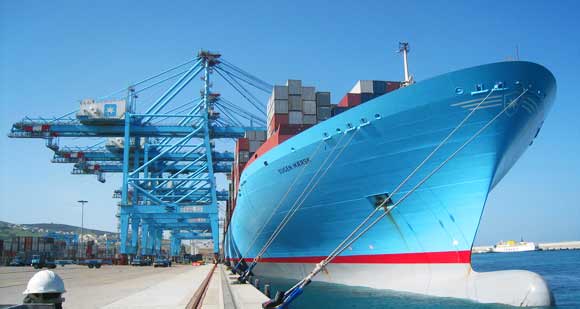
The Newest, Largest, and Busiest Port in Africa: Tangier-Med
>The Newest, Largest, and Busiest Port in Africa: Tangier-Med
>Port Tangier-Med Industrial and Free Trade Zones
>Example: Renault-Nissan at Tangier-Med/Free Zone
>Dry Ports and Transportation
The Newest, Largest, and Busiest Port in Africa: Tangier-Med
After the goals of increasing tourism, and establishing Free Trade Agreements (FTAs) with as much of the world as possible—Morocco now has FTAs with country markets containing more than 1 bil. people—the third strategic goal of Vision 2010 was to establish Morocco as one of the great trading, logistics, and transshipment hubs between four continents—Europe, North and South America, Aftica—and the Middle East. The most spectacular development in this regard is the opening of the new port of Tangier-Med.
Port Tangier-Med is a new cargo port located 40 km. east of the city of the famous city of Tangier. It has grown from nothing more than a gleam in the eye of King Mohammed VI in 2001, to an entirely new set of modern port facilities that are designed to the largest port on the Mediterranean Sea, as well as the largest port in all of Africa. By 2005, the planning stage was completed and construction began, resulting in the opening of the first phase of the Port in 2007—called Tangier-Med I—with an initial capacity or 3.5mil. shipment containers.
The success of the Tangier-Med complex has been phenomenal. Tangier-Med offers 48 maritime services linking it to 120 international ports (37 in Europe, 31 in Asia, 30 in Africa, 16 in South America, and 6 in North America)
Financing was put in place and construction begun in 2009 for phase two of the Port—called Tangier-Med II—to meet the quickly growing demand for containertransshipment at the international level in sea transport. The new port facilities at Tanger-Med II are designed to for 2 new container terminals with a total length of 2.8 km., and a nominal capacity of an additional 5 million containers. The European Investment Bank (EIB) provided a loan of 200 mil. Euros to finance Tangier-Med II.
The success of the Tangier-Med complex has been phenomenal. Tangier-Med offers 48 maritime services linking it to 120 international ports (37 in Europe, 31 in Asia, 30 in Africa, 16 in South America, and 6 in North America). Container traffic in 2010 totaled more than 2 mil. TEUs (20-foot equivalent units), and a total of 23 million tons. Within 3 years of opening the first phase, the Tangier-Med port now carries 70% of Morocco’s export/import trade.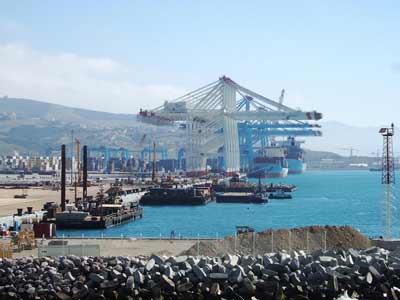
In addition to container traffic, Tanger-Med has also built a striking new passenger terminal, which replaces the city of Tangier as the port destination for ferries and passenger ships from Europe. In 2010, 1,156,731 passengers; 384,667 vehicles; and 5,010 buses passed through the port.
Overall, the vision for Tangier-Med is awesome. According to Jamal Mikou,
CEO of Tangier Free Zone, the completion of Tangier-Med phases I and II will “mark us as one of the greatest ports in the Mediterranean or even world-wide. It is the only port constructed in the 21st century. So we are will benefit from the latest harbor technology.”
The Tanger-Med project has already provided thousands of jobs for Moroccans, and is expected to eventually create 100,000 new jobs directly, and many more indirectly.
Port Tangier-Med Industrial and Free Trade Zones
Despite the huge boost given to the economy of Morocco by the success of the Tangier-Med port complex, which now places in Morocco the largest, most modern, and best located container, transshipment, and logistics port in the entire Mediterranean and the whole continent of Africa, the port facilities themselves are not the only, and may not even be the primary, advantage of Tangier-Med.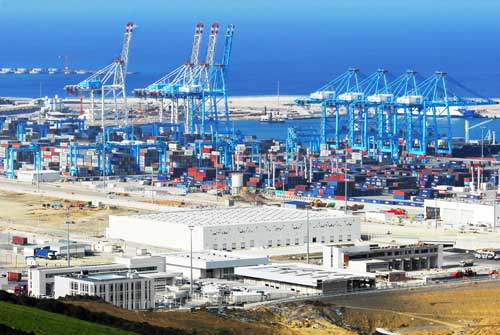
For the Tangier-Med port is built as only a part of a larger plan, the most important component of which is the Tangier Free Trade Zone, which is fast becoming a major magnet for new industries as well as industries from other countries relocating to Morocco. According to Jamal Mikou, CEO of Tangier Free Zone,
“It’s not just creating a port and nothing else: there’s the port and the industrial component because it’s the latter that will cause the port to work. So, what we have is a big industrial platform…that we can offer
today to the industrialists.”
The industrial free zone associated with the new port has 500 hectares, and has attracted over 500 companies. What attracts new companies and new investors are three major factors that work to their advantage;
- Speed. Businesses want goods produced and deliverer quickly. This has two dimensions. First, loacation: Tangier-Med is only 14 km. from Europe; and 2) the most modern facilities in the world. The old port of Tangier as fast, but the new Port Tangier-Med is much faster. What t his means, says Mikou, is that “in less than 24 hours goods can be delivered in Paris.”
- A Free Trade Zone dispenses with bureaucratic paperwork. Says Mikou, “We have simply decided to cancel all administrative procedures to set up business.” Building permits are issued in less than 24 hours. “I do not know many countries in the world that are capable of providing this license in such a short time,” adds Mikou.
- A Free Trade Zone not only expedites business startups, but also frees exporters from customs, duties, and many taxes. Says Mikou, “it facilitates shipping to considerably reduce logistic costs, which is our work today.”
Example: Renault-Nissan at Tangier-Med/Free Zone
One of the major companies attracted by the advantages of both the port and the free trade zone is a new Renault-Nissan plant. Although Renault has been manufacturing automobiles for domestic sales in Morocco since 1928, it began a new plant in the free zone to produce automobiles for export, initially 200,000 autos, rising eventually to 400,000—90% of which will be exported. The plant is expected to employ 6,000 workers.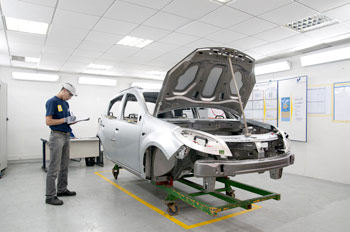
Of course, automobile productions is not the only industry locating in the Tangier Free Zone to take advantage of its connections to the world; this Zone has also attracted hundreds of other industrial plants in just about every other sector of the economy, from aviation parts to computer engineering and IT, from textiles to education and training.
Dry Ports and Transportation
But even describing both the port facilities and the industrial free zone them is not sufficient to convey the whole picture of Tanger-Med’s importance. For, in order for this port to succeed in becoming the major point for import and export shipping, a vast infrastructure of highways, railroads, and air routes had to be set up to carry goods to and from both the ports and its surrounding industries.
These, too, were factored into the planning for Tangier-Med, and an entire transportation system developed, constructed, and modernized to serve an increasingly industrialized export base for the Moroccan economy, and a distribution system to deliver imported goods to a Moroccan population. This extended transportation system is as much a part of the conception and planning for Tangier-Med as the port itself.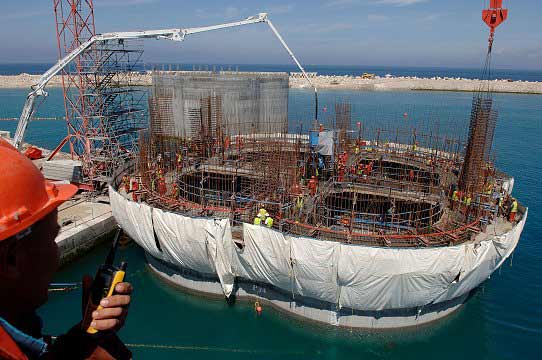
But, there is more. Connected to the Tangier-Med Port and the Tangier Free Zone by the transportation system is also another set of new economic institutions called “dry ports.” What these are, are special zones, sometimes free zones or special economic zones, that are located inland, but which function the same way as a port on the sea. In other words, a manufacturer can deliver its goods to a “dry port,” where they will be invoiced, packed, and shipped from that point by rail, truck, or air, exactly as if they had been delivered to a “wet port” on the sea, with all of the intervening problems of transporting goods taken care of the whole way to the final destination. In effect, dry ports function as extensions of the seaport into the interior of the country.
Thus industrial development for export can take place anywhere in the country as easily as near the sea. It needs to be added that this interconnection of Tangier-Med to dry ports by the transportation system serves agriculture, tourism, and even handicrafts as much as it does industrial goods.
Tangier’s Free Trade Zone has become the most important trade and business hub in Morocco: attracting industries to locate in Morocco, increasing exports, providing employment to tens of thousands, and connecting the entire economy to international markets. It has attracted billions of dollar and euros to Morocco as Foreign direct investment (FDI), and established Morocco as one of the most important trade and industrial centers in the MENA region.